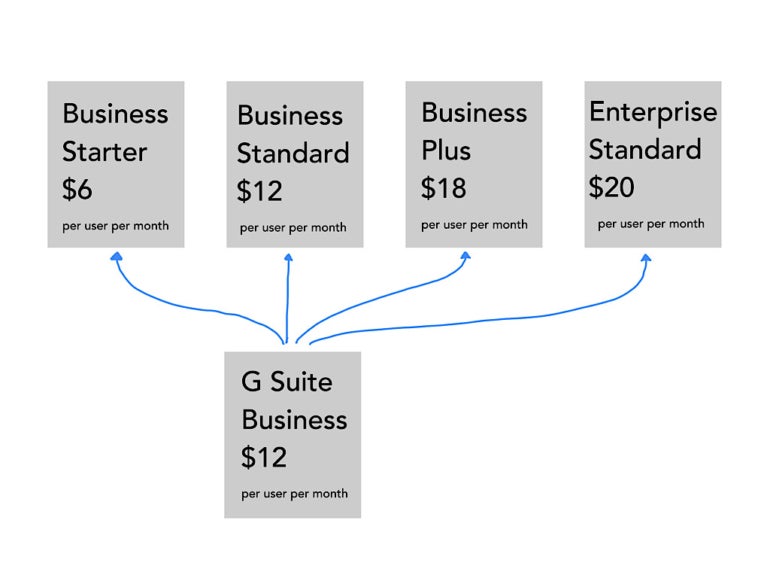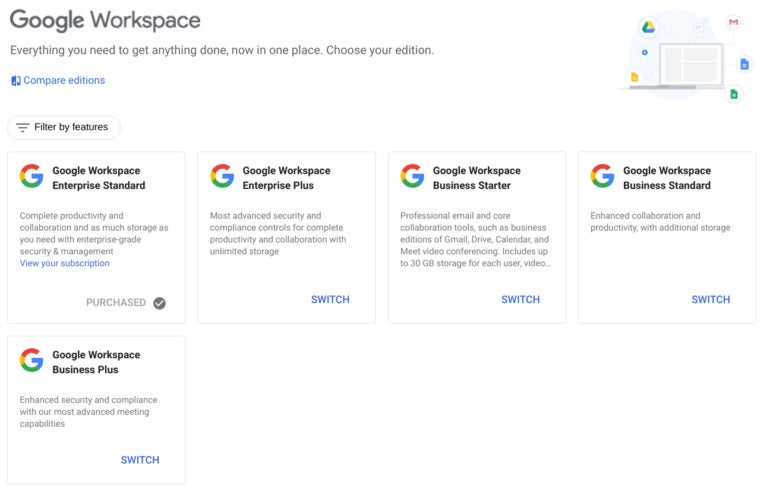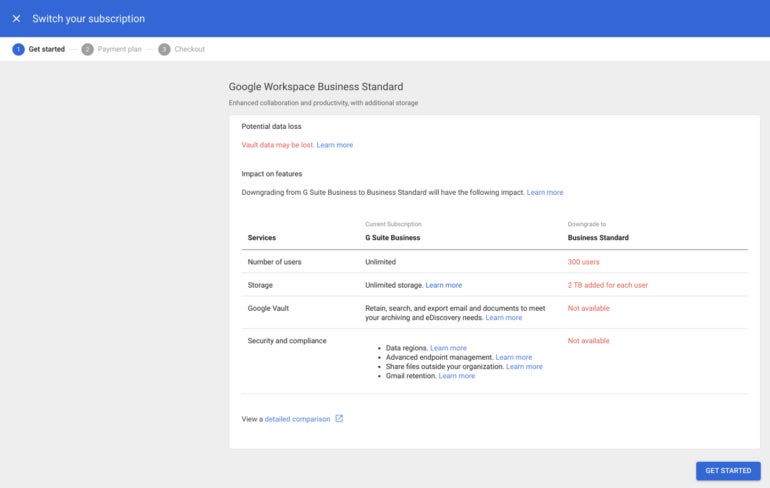
Google Workspace represents a rebranding of the set of applications formerly known as G Suite. The announcement signaled Google’s desired direction: a unified workspace. Google Workspace pricing, however, sends a more significant signal than the renaming of Google’s current app offerings.
Here’s a look at the current Google Workspace plans and pricing, along with key features you might consider when selecting a plan.
Jump to:
Plans and pricing for Google Workspace
Google Workspace’s plans
Google Workspace now offers three Business plans — Starter, Standard and Plus — and two Enterprise plans — Standard and Plus (Figure A). An additional option, Google Workspace Essentials Starter, allows teams of up to 25 people to use Google’s collaboration tools, such as Google Docs, alongside an existing email and calendar collaboration system.
Figure A

Pricing for Google Workspace Business plans
- Google Workspace Business Starter: $6 per user per month
- Google Workspace Business Standard: $12 per user per month
- Google Workspace Business Plus: $18 per user per month
Pricing for Google Workspace Enterprise plans
Pricing for Enterprise plans is not published. As a legacy customer, when I walked through the upgrade process, the offers I saw included the following; the per user pricing Google offers your organization for Enterprise plans may be different.
- Google Workspace Enterprise Standard: $20 per user per month
- Google Workspace Enterprise Plus: $30 per user per month
Google requires that new customers who seek Enterprise licenses contact Sales. Note that there is no minimum or maximum number of users for Enterprise plans.
Google provides a comparison page with an overview that compares legacy G Suite Basic and Business plans to currently offered Business Starter, Standard and Plus plans (Figure B).
Figure B

Current customers can either remain on a prior plan, such as G Suite Basic, Business or Enterprise, through the terms of the plan or choose to switch to a new Workspace plan. Prior G Suite Education and Nonprofit plan customers may move to similar Google Workspace for Education or Google Workspace for Nonprofits editions.
The adjusted prices align Google Workspace pricing more closely with Microsoft 365. For example, Microsoft lists pricing for its 365 Business offerings as:
- Microsoft 365 Business Basic: $6 per user per month
- Microsoft 365 Business Standard: $12.50 per user per month
- Microsoft 365 Business Premium: $22 per user per month
Key features of some Google Workspace and G Suite plans
The following analysis compares key features of Business Starter, Business Standard and Business Plus plans with legacy G Suite Basic and Business plans.
User limits
The Google Workspace Business plans all add one key constraint not previously present in prior G Suite plans: a maximum of 300 users. If you need more than 300 user accounts, you’ll need an Enterprise plan. Microsoft similarly sets a limit of 300 user accounts on its Microsoft 365 Business plans.
Storage limits
Per user limits for Google Workspace Business storage plan are:
- 30GB per user for Business Starter
- 2TB per user for Business Standard
- 5TB per user for Business Plus
Unlimited storage is now available only with Workspace Enterprise plans.
SEE: Google Workspace storage: 3 essential things you need to know (TechRepublic)
All files created, added or modified after June 1, 2021, count toward a user’s storage limit. Files such as Google Docs, Sheets, Slides, Drawings, Forms, Sites, images (e.g., JPG, PNG), PDFs, Word, Excel, PowerPoint and other formats will count toward storage limits.
| Google Workspace edition plan | Storage limit |
|---|---|
| Essentials Starter | 15GB per user |
| Business Starter | 30GB per user |
| Business Standard | 2TB per user |
| Business Plus | 5TB per user |
| Enterprise Standard/Plus | As much as you need |
External sharing
Of the three Google Workspace Business plans, both Business Standard and Business Plus offer an administrator the ability to restrict and manage external file sharing with specific domains. Historically, G Suite Basic and G Suite Business allowed an administrator to prevent external file sharing.
Google Meet recording
Business Standard and Business Plus add the ability to record and save Google Meet video conferences. While Google had made recording available to G Suite users in support of COVID-19 work-from-home initiatives, recording had not been a standard benefit of either G Suite Basic or G Suite Business plans.
The maximum number of Google Meet participants for the plans are:
- 100 people for Business Starter
- 150 people for Business Standard
- 500 people for Business Plus
Google’s feature comparison page lists several Meet features, such as polling and Q&A and breakout rooms, all of which require a Business Standard or better account. Business Plus and better plans also support attendance tracking in Meet.
E-discovery and retention
Google Vault is the organization’s offering to support administrative e-discovery and data retention. Only Business Plus includes Google Vault; although, organizations on Starter and Standard may select Vault as a paid add-on. When I browsed through my offered pricing, Vault displayed a $5 per user per month add-on price. Historically, the G Suite Business plan included Google Vault.
How to choose a new Google Workspace plan
If you’re a new customer, your task is relatively simple. Define your needs, select the plan that best fits the balance of your needs and your budget, then help people in your organization get started with Workspace.
If you have been a G Suite or Google Workspace customer, an administrator can sign in to the Admin console to access account options. To do this, the admin would sign in at https://admin.google.com, select the three-horizontal line menu in the upper left corner, then choose Billing, and select Get More Services from the sub-menu.
If you are a current customer, the Google Admin Get More Services page highlights available Google Workspace plans (Figure C).
Figure C

Select any of the options, and the system will display the details of key features your account will either gain or lose. Select your option, address any identified issues and follow any step-by-step instructions to switch.
How to update G Suite Business to a Google Workspace plan
In recent years, I’ve been on the G Suite Business plan, which was $12 per user per month. Here’s how I considered the three new Workspace options.
First, I could choose to spend the same amount: $12 per user per month for Google Workspace Business Standard (Figure D).
Figure D

Google labeled this a downgrade, since I would be allowed fewer users (300, not unlimited) and less storage (2TB per user, not unlimited), and I would lose Google Vault, access to data regions, endpoint management features and more.
Second, I could choose to spend more: $18 per user per month for Google Workspace Business Plus. I would be allowed fewer users (300, not unlimited) and less storage (5TB per user, not unlimited).
Third, I could choose to spend $20 per user, per month for Google Workspace Enterprise Standard. With this option, I kept the ability to add unlimited users, have unlimited storage, and gain some security controls.
I upgraded to Enterprise Standard, because I value access to enterprise features for my writing and work. Organizations on other plans will have different considerations and priorities.
If you’re an admin managing Google Workspace plans, this Cloud Computing Policy from TechRepublic Premium might come in handy.
What do you think of these Google Workspace plans?
It will be interesting to see the reaction of savvy IT adopters who selected G Suite or Google Apps in the past precisely because Google allowed an unlimited number of users for all paid plans. Will those customers choose to pay more, or will they see this as an opportunity to explore alternatives? Let me know what you think of the newest Google Workspace plans and pricing via Mastodon (@awolber).